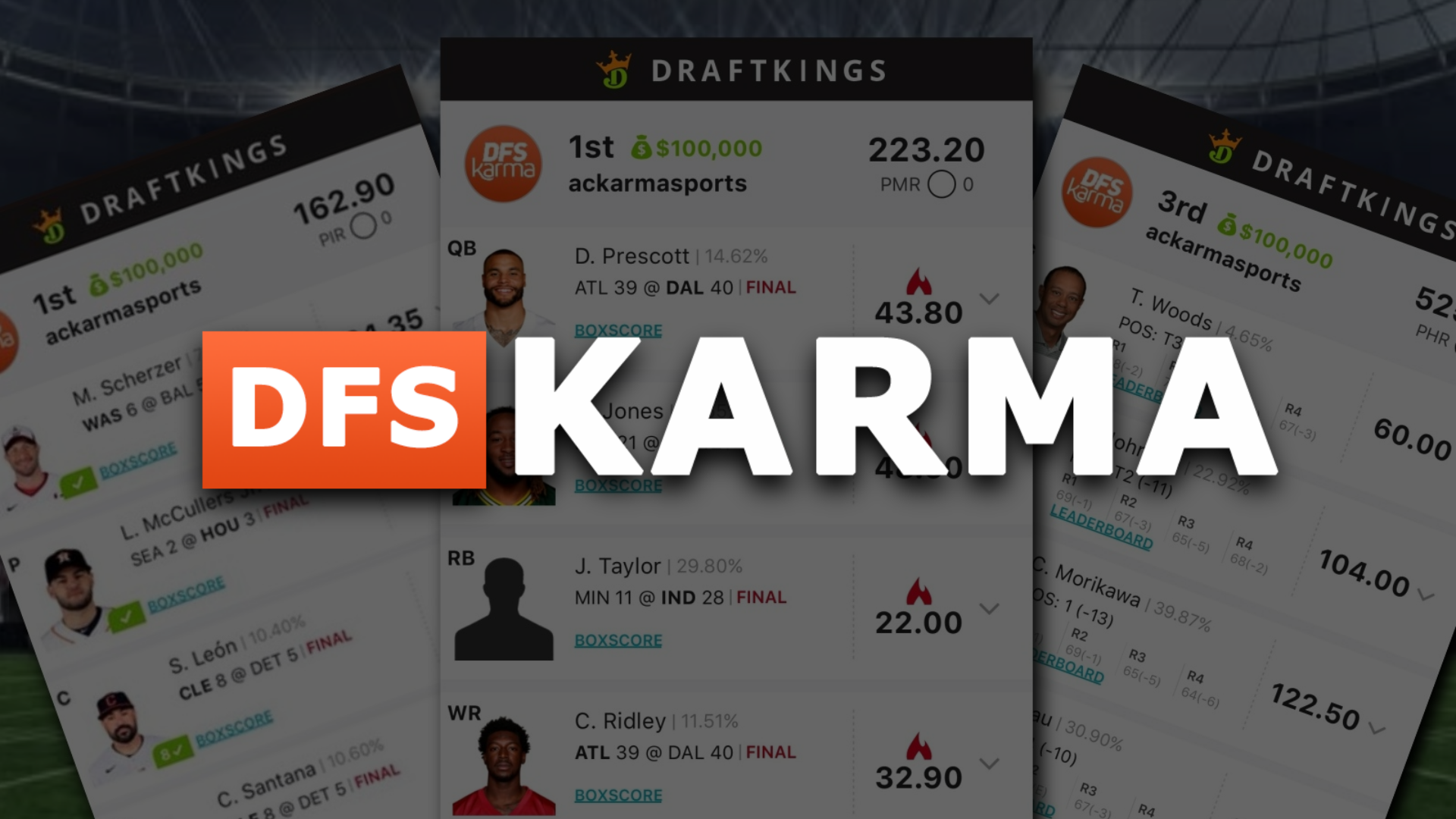
Welcome back to the Data Viz DFS NFL Preview utilizing data science & data visualizations – today we are changing up the vibe a little. Rather than previewing a specific week, we will be looking back on the first 8 weeks & will highlight key takeaways that are interesting (minimum 3 games played & 8 DK Pts per game).
We will be utilizing red zone receptions, red zone targets, & total TDs to see if we can understand the WR position a little better & predict what WRs will have value for the second half of the season. Before we get into why I chose these statistics I would highly recommend going back and reading LAST WEEKS ARTICLE to get a refresher on some key data science terms. I introduced scatter plot, correlation, correlation score, & positive correlation to give us a better idea of what statistics will be useful when predicting future WR performance. I would highly recommend going back and reading LAST WEEK ARTICLES, but for those who do not I will insert some key terms that will be useful for today’s analysis below.
Key Terms:
Scatter Plot: A graph where the values of two variables are plotted along two axes (x & y), the pattern of the resulting points reveal if any correlation is present. The purpose of a scatter plot is to show possible associations or relationships between two variables.
Correlation: The process of establishing a relationship or connection between two or more variables.
Positive Correlation: The values of one variable increase as the values of the other increase. Basically if you improve one variable – you will see improvement in the other.
R Squared Score / Correlation Score: The main purpose is to predict future outcomes on the basis of other related information. In general the higher the R-squared score, the more confident you can be when predicting future outcomes.
Okay back to your normally scheduled programming – Data Viz WR Recap.
For this weeks analysis we will be utilizing WR red zone statistics. After running a correlation analysis – I found red zone receptions has a .51 correlation score, red zone targets has a .54 correlation score, & total TDs has a .63 correlation score when compared to fantasy points per game. If you recall from last week – this means these statistics all have a relationship or connection to fantasy points per game & more importantly a positive correlation – as one increases the other will most likely increase as well.
Today’s first viz is 3 different scatter plots – each being statistics on the x-axis compared to fantasy points per game (y axis). The three statistics on the x-axis are: red zone receptions, red zone targets, & total TDs. Each circle represents a different WR, the color is based on total fantasy points (blue is good & orange is bad), & all are positively correlated based on their r squared score (>.5).
Key Takeaways:
Red zone performance is very important for WRs to be successful in fantasy football. This is not a huge surprise considering red zone opportunities lead to TDs, but when looking into the numbers it is even more of a factor that I anticipated (more on this to come).
Both red zone receptions & red zone targets have a high correlation score (.51 & .53). We can rely heavily on these 2 statistics to predict future performance. Due to the high correlation score we feel comfortable utilizing these to analyze the position & help us make educated decisions for week 9 WR performance.
Total TDs comes in with the highest of correlation scores among the group (.63) – this is relatively obvious because the equation for fantasy points includes TDs. But the biggest takeaway is we need WRs that can convert red zone opportunities – that is the most sure fire way of predicting what WR will have a good fantasy week.
These scatter plots & correlation scores tell us that these 3 statistics can be utilized to predict future WR performance. Basically going forward we are looking for WRs that are heavily targeted in the red zone & are able to convert those targets into catches & even more importantly TDs. This is today’s focus – trying to understand what WRs have convert red zone opportunities & will continue doing so the remainder of the season.
This viz is a stacked bar graph ordered by red zone receptions, the width of the bar represents red zone targets, & the color of the bar represents total TDs (blue is good & orange is bad). All three statistics represented have a positive correlation when compared to fantasy points per game – continue reading for the some key takeaways from the first half of the season.
High Red Zone Receptions (5 to 10 Receptions)

Key Takeaways:
Julian Edelman Is A Beast – Edelman is easily the most reliable red zone WR. He is the highest targeted and leads the league in red zone receptions (3 higher than 2nd place). To put this in perspective he has double the amount of red zone receptions than the following beastly WRs: Mike Evans, Julio Jones, DeAndre Hopkins, & Allen Robinson. Due to his stature you may not expect Edelman to be such a force in the red zone but to his rapport with Tom Brady & reliable hands – he is in a class of his own. It is remarkable that he is able to be so highly productive while being undersized for his position. Expect this to continue for the rest of the season – we can count on Edelman being a force in the red zone & putting up big fantasy weeks.
Top WRs Perform In The Red Zone – Out of the WRs with 5 or more red zone receptions – only one WR ranked outside the top 25 total fantasy points. This tells me that red zone performance leads directly to elite fantasy WRs. Let’s try and target WRs that will be targeted in the red zone week in and week out.
WR Receptions Equals TDs – This one is pretty straight forward – but I would be remiss if I didn’t at least state the obvious. The more receptions a WR receives in the red zone the more likely they will have a high TD Total (12/17 scored > 4 TDS).
Emmanuel Sanders Should Have More Fantasy Points – Sanders is tied for second with 7 red zone receptions & is also targeted at a very high rate (3rd highest w/ 10). Sanders was recently traded to a much better team – the 49ers – but they are also very run dependent. I believe Sanders is elite and will perform the rest of the season, but I cant blame you for taking a wait and see approach until it is more clear how Sanders fits in with the 49ers.
Lions & Bucs Have 2 WRs Each That Have High Red Zone Receptions – This isn’t necessarily a positive for these WRs. Obviously all 4 (Marvin Jones / Golladay / Mike Evans / Godwin) are legit – but due to the fact they are lining up across from each other – they may have limited value week to week. It is difficult to predict each week which of the duo will go off – so for a more conservative approach I normally stay away from these type of situations.
I Wish Courtland Sutton Had A Real QB – Sutton has found a way to be very reliable even though his QB situation has been far from stellar. Imagine if Sutton had an average QB – what would his numbers look like? Now going forward it appears his QB situation is getting surprisingly worse. I still think Sutton has value but I will not trust him until I see what kind of game Brandon Allen has.
Ditto for Allen Robinson – Just go back and read the above for Allen Robinson, it saves me the write-up & replace Brandon Allen with whatever QB the Bears rolls out.
Terry McLaurin Is Having A Sneaky Good Season – Ranking 16th in overall fantasy points, 4th in red zone receptions, & 3rd in total TDs among WRs. McLaurin has proven himself week in and week out that he the real deal Holyfield. Expect McLaurin to continue this production the remainder of the year.
Tyler Lockett Is A Sneaky Good Red Zone WR – Ranking 3rd in red zone receptions makes Lockett a legit red zone target. He has also been able to convert those receptions into TDs – Lockett is a stud and should be drafted as one for the second half of the season.
Thanks for reading these key takeaways, hopefully it helped shed some light on why WRs have value week in and week out. Below are the remainder of the WRs – I created a viz for each number of red zone receptions. Take a deep dive into each for more analysis.
Ask me any questions about Data, Visuals, DFS, etc. on Twitter (@StephenDataViz) or Instagram (@StephenDataViz)












